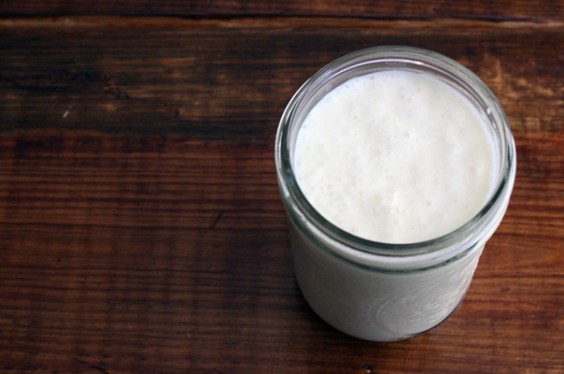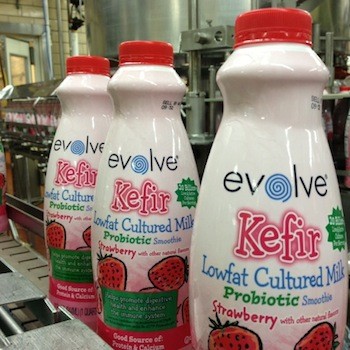#WTF is Kefir?
Greatist’s #WTFis series looks at new trends in health and fitness to explain what the heck they are, why people care, and if they live up to the hype.

Photo: Food Loves Writing
Smooth and creamy. Filled with the "good" kind of bacteria. Drinkable or spoonable. Available in flavors such as strawberry, blueberry, and peach.
Yogurt, right? Nope, it’s kefir (that’s KEE-fer), yogurt’s less widely known relative that may have already arrived at a grocery store near you. Some health experts say kefir boasts many of the same health benefits as yogurt, such as boosting immunity, reducing inflammation, and easing symptoms of lactose intolerance ((Kefir: a symbiotic yeasts-bacteria community with alleged healthy capabilities. Lopitz-Otsoa, F., Rementeria, A., Elquezabal, N., et al. Departamento de Immunologia, Microbiologia y Parasitologia, Facultad de Farmacia, Universidad del Pais Vasco-Euskal Herriko, Univertsitatea, Vitoria-Gasteiz, Spain. Revista Iberoamericano de Micologia, 2006 Jun;23(2):67-74.)). A cup of kefir also typically packs even more active cultures (the bacteria that promote digestion) than the same amount of yogurt. It may be a while before kefir is standard snack-time fare in the U.S., but in the meantime manufacturers are trying to make the product more like yogurt — tasty and easy to eat — hoping that kefir will achieve some of yogurt’s huge and growing popularity.
What’s the Deal?
Like yogurt, kefir has been around for centuries. It was originally eaten by Muslim tribes in the Northern Caucasus mountain region, who believed it was a gift from Allah ((Kefir: a symbiotic yeasts-bacteria community with alleged healthy capabilities. Lopitz-Otsoa, F., Rementeria, A., Elquezabal, N., et al. Departamento de Immunologia, Microbiologia y Parasitologia, Facultad de Farmacia, Universidad del Pais Vasco-Euskal Herriko, Univertsitatea, Vitoria-Gasteiz, Spain. Revista Iberoamericano de Micologia 2006 Jun;23(2):67-74.)). For years, families passed down kefir “grains” (a combination of yeast and bacteria from which kefir is made — not an actual grain at all) as a source of wealth, and even back then, some said the food had special healing powers ((Kefir: a symbiotic yeasts-bacteria community with alleged healthy capabilities. Lopitz-Otsoa, F., Rementeria, A., Elquezabal, N., et al. Departamento de Immunologia, Microbiologia y Parasitologia, Facultad de Farmacia, Universidad del Pais Vasco-Euskal Herriko, Univertsitatea, Vitoria-Gasteiz, Spain. Revista Iberoamericano de Micologia, 2006 Jun;23(2):67-74.)).
Kefir milk (the stuff typically found in the dairy aisle at the grocery store) comes to life when kefir grains are added to milk and incubated for about 22 hours ((Review: functional properties of kefir. Guzel-Seydim, Z.B., Kok-Tas, T., Greene, A.K., et al. Department of Food Engineering, Suleyman Demirel University, Isparta, Turkey. Critical Reviews in Food Science and Nutrition, 2011 Mar;51(3):261-8.)). The kefir is edible once that cultured milk is filtered, and the resulting product has a slightly sour taste similar to yogurt’s ((Kefir: a symbiotic yeasts-bacteria community with alleged healthy capabilities. Lopitz-Otsoa, F., Rementeria, A., Elquezabal, N., et al. Departamento de Immunologia, Microbiologia y Parasitologia, Facultad de Farmacia, Universidad del Pais Vasco-Euskal Herriko, Univertsitatea, Vitoria-Gasteiz, Spain. Revista Iberoamericano de Micologia, 2006 Jun;23(2):67-74.)). The difference is that there’s no such thing as “yogurt grains” — to make yogurt, we just add certain bacteria to milk. Kefir’s also incubated for a little longer than yogurt is, meaning that it's slightly higher in probiotics that can aid digestion and ease symptoms of gastrointestinal disorders. Another option is water kefir, a slightly sour, fermented beverage, that’s produced when kefir grains are added to water. It’s also a good source of probiotics, though it’s slightly less concentrated than milk kefir.
A bowl of kefir grains may no longer be something we leave in our safe deposit box, but there may be science behind some of those special “healing powers.” The variety of bacteria in a cup of kefir may be able to fight off some types of problem-causing bacteria in the body, such as Enterobacteriaceae and clostridia ((Dietary influence of kefir on microbial activities in the mouse bowl. Marquina, D., Santos, A., Corpas, I., et al. Department of Microbiology III, Biology Faculty, Complutense University of Madrid, Madrid, Spain. Letters in Applied Microbiology, 2002;35(2):136-40.)) ((Kefir: a symbiotic yeasts-bacteria community with alleged healthy capabilities. Lopitz-Otsoa, F., Rementeria, A., Elquezabal, N., et al. Departamento de Immunologia, Microbiologia y Parasitologia, Facultad de Farmacia, Universidad del Pais Vasco-Euskal Herriko, Univertsitatea, Vitoria-Gasteiz, Spain. Revista Iberoamericano de Micologia, 2006 Jun;23(2):67-74.)). Those probiotics also stimulate the emptying of the digestive system, the opposite of what milk and cheese typically do. And while kefir is a dairy product, it can sometimes ease symptoms of lactose intolerance as well as other digestive issues such as irritable bowl syndrome and celiac disease ((Kefir improves lactose digestion and tolerance in adults with lactose maldigestion. Hertzler, S.R., Clancy, S.M. Medical Dietetics Division, School of Allied Medical Professions, The Ohio State University, Columbus, USA. Journal of the American Dietetic Association, 2003 May;103(5):582-7.)) ((Kefir: a symbiotic yeasts-bacteria community with alleged healthy capabilities. Lopitz-Otsoa, F., Rementeria, A., Elquezabal, N., et al. Departamento de Immunologia, Microbiologia y Parasitologia, Facultad de Farmacia, Universidad del Pais Vasco-Euskal Herriko, Univertsitatea, Vitoria-Gasteiz, Spain. Revista Iberoamericano de Micologia, 2006 Jun;23(2):67-74.)). That’s because the probiotics in kefir help break down the sugars in milk so our stomachs don’t have to. Other research suggests kefir can boost immunity, reduce inflammation, and even reduce the risk of cancer ((The effect of kefir consumption on human immune system: a cytokine study. Adiloglu, A.K., Gonulates, N., Isler, M., et al. Department of Medical Microbiology, Ankara Education and Research Hospital, Ankara, Turkey. Mikrobiyoloji Bulletin, 2013 Apr;47(2):273-81.)) ((Anti-inflammatory properties of kefir and its polysaccharide extract. Rodrigues, K.L., Carvalho, J.C., Schneedorf, J.M. Laboratrio de Fitofarmacos, Unifenas, Minas Gerais, Brazil. Inflammopharmacology, 2005;13(5-6):485-92.)) ((Kefir: a symbiotic yeasts-bacteria community with alleged healthy capabilities. Lopitz-Otsoa, F., Rementeria, A., Elquezabal, N., et al. Departamento de Immunologia, Microbiologia y Parasitologia, Facultad de Farmacia, Universidad del Pais Vasco-Euskal Herriko, Univertsitatea, Vitoria-Gasteiz, Spain. Revista Iberoamericano de Micologia, 2006 Jun;23(2):67-74.)). Some studies have found that mice who consumed fermented milk showed lower cholesterol levels, but there's some debate over whether the same findings apply to humans ((Kefir: a symbiotic yeasts-bacteria community with alleged healthy capabilities. Lopitz-Otsoa, F., Rementeria, A., Elquezabal, N., et al. Departamento de Immunologia, Microbiologia y Parasitologia, Facultad de Farmacia, Universidad del Pais Vasco-Euskal Herriko, Univertsitatea, Vitoria-Gasteiz, Spain. Revista Iberoamericano de Micologia, 2006 Jun;23(2):67-74.)).
Is It Legit?
 Maybe. It’s worth noting that when it comes to kefir, research on humans is still limited. (Most studies have been conducted on rodents.) Moreover, the kind of kefir that’s used in laboratory trials may differ from the kind we find on store shelves. As of now there’s no standard protocol for making kefir, either for use in clinical trials or for companies to sell ((Kefir: a symbiotic yeasts-bacteria community with alleged healthy capabilities. Lopitz-Otsoa, F., Rementeria, A., Elquezabal, N., et al. Departamento de Immunologia, Microbiologia y Parasitologia, Facultad de Farmacia, Universidad del Pais Vasco-Euskal Herriko, Univertsitatea, Vitoria-Gasteiz, Spain. Revista Iberoamericano de Micologia, 2006 Jun;23(2):67-74.)). That means the amount and variety of probiotics may differ between different brands of kefir.
Maybe. It’s worth noting that when it comes to kefir, research on humans is still limited. (Most studies have been conducted on rodents.) Moreover, the kind of kefir that’s used in laboratory trials may differ from the kind we find on store shelves. As of now there’s no standard protocol for making kefir, either for use in clinical trials or for companies to sell ((Kefir: a symbiotic yeasts-bacteria community with alleged healthy capabilities. Lopitz-Otsoa, F., Rementeria, A., Elquezabal, N., et al. Departamento de Immunologia, Microbiologia y Parasitologia, Facultad de Farmacia, Universidad del Pais Vasco-Euskal Herriko, Univertsitatea, Vitoria-Gasteiz, Spain. Revista Iberoamericano de Micologia, 2006 Jun;23(2):67-74.)). That means the amount and variety of probiotics may differ between different brands of kefir.
For a long time, kefir wasn’t available in most supermarkets and only came in drinkable form. Now the product comes in a number of different styles (frozen and spoonable, for example) and it’s making an appearance at more and more traditional grocery stores. Julie Smolyansky, CEO of Lifeway, attributes kefir’s growing popularity to increasing rates of gastrointestinal issues and people looking for holistic remedies.
Lately kefir manufacturers have been trying to come up with products more similar to yogurt, specifically Greek yogurt, to keep up with consumers’ growing demand for high-protein foods. Lifeway, the biggest U.S. manufacturer of kefir products, released a Greek-style drinkable kefir in 2006. Evolve has just come out with six-ounce cartons of “spoonable” Greek kefir, available in grocery stores around New York City. Cyrus Schwartz, CEO of Evolve, says he’s hoping to target more health-savvy consumers, who know what probiotics are and appreciate kefir’s high probiotic count.
Want to try it for yourself? Now that kefir comes in single-serving containers, similar to yogurt packaging, it’s easier to control how much we eat. But the same concerns about excess sugar in flavored yogurt apply to kefir. In general, says Greatist Expert and dietitian Jessica Redmond, one serving of kefir or yogurt should contain more grams of protein than sugar.
Special thanks to Lisa Moskovitz and Jessica Redmond for their contributions to this article.
Have you tried kefir? Did you like it as much as yogurt? Let us know in the comments below or find the author at @ShanaDLebowitz.
No comments:
Post a Comment